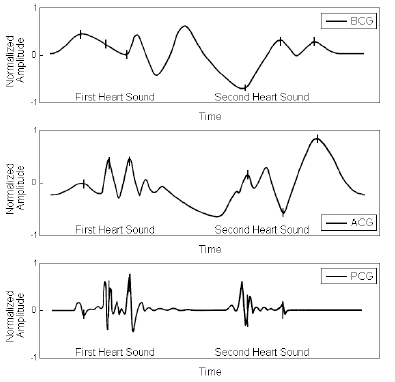Theory and developments in an unobtrusive cardiovascular system representation: ballistocardiography
- PMID: 21673836
- PMCID: PMC3111731
- DOI: 10.2174/1874120701004010201
Theory and developments in an unobtrusive cardiovascular system representation: ballistocardiography
Abstract
Due to recent technological improvements, namely in the field of piezoelectric sensors, ballistocardiography - an almost forgotten physiological measurement - is now being object of a renewed scientific interest.Transcending the initial purposes of its development, ballistocardiography has revealed itself to be a useful informative signal about the cardiovascular system status, since it is a non-intrusive technique which is able to assess the body's vibrations due to its cardiac, and respiratory physiological signatures.Apart from representing the outcome of the electrical stimulus to the myocardium - which may be obtained by electrocardiography - the ballistocardiograph has additional advantages, as it can be embedded in objects of common use, such as a bed or a chair. Moreover, it enables measurements without the presence of medical staff, factor which avoids the stress caused by medical examinations and reduces the patient's involuntary psychophysiological responses.Given these attributes, and the crescent number of systems developed in recent years, it is therefore pertinent to revise all the information available on the ballistocardiogram's physiological interpretation, its typical waveform information, its features and distortions, as well as the state of the art in device implementations.
Keywords: Ballistocardiography; biomedical measurements; cardiac signal analysis; cardiovascular system monitoring; unobtrusive instrumentation..
Figures








References
-
- NASA. “Ballistocardiography - a bibliography”. NASA SP-7021 (FAA AM 65-15) 1965. Sep,
-
- Scarborough W R, Baker B M. “Ballistocardiography - appraisal of current status”. Circulation. 1957;16:971–975. - PubMed
-
- Gubner R S, Rodstein M, Ungerleider H E. “Ballistocardiography - an appraisal of technic, physiologic principles, and clinical value,”. Circulation. 1953;7:268–286. - PubMed
-
- Henderson Y. “The mass-movements of the circulation as shown by a recoil curve”. Am. J. Physiol. 1905;14:287.
LinkOut - more resources
Full Text Sources
Other Literature Sources
